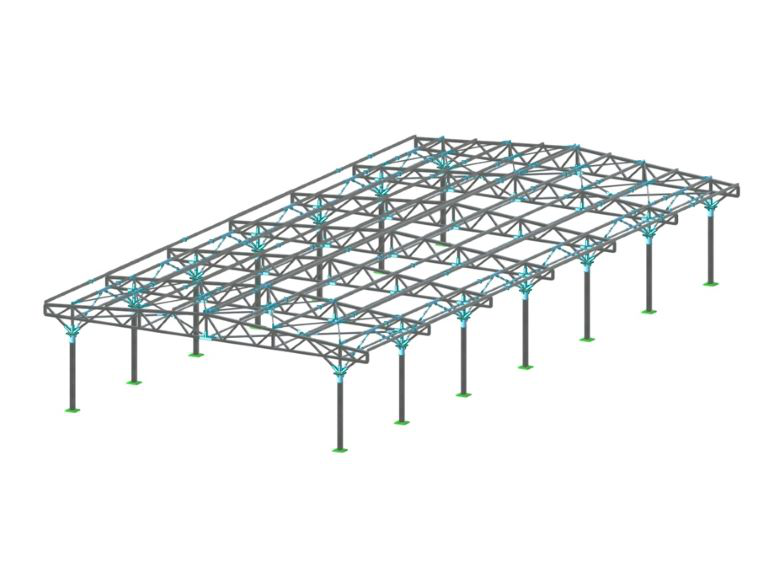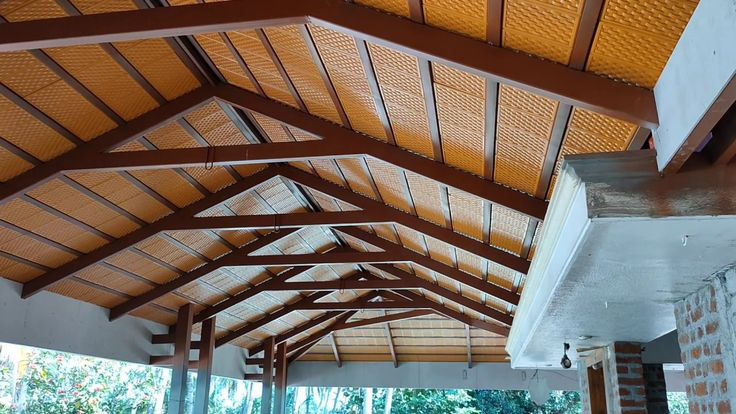Thinking about building a home, shoplot, warehouse—or maybe a dream factory in Malaysia? One thing you absolutely can’t afford to overlook is roof structure design. A poorly planned roof isn’t just an eyesore; it can lead to leaks, structural failure, and even higher electricity bills.
Here are 7 powerful tips (with a splash of humor) to help you nail your roof design like a pro.

1. Choose the Right Truss System for Your Project
Every building type in Malaysia—from kampung homes to commercial buildings—needs a different roof truss system. The most common types include:
-
King Post Truss – Perfect for smaller residential spaces.
-
Howe Truss – A solid choice for mid-sized buildings.
-
Steel Roof Trusses – Best for factories or large commercial sites.
Choosing the right truss system affects your building’s load-bearing capacity, ventilation, speed of construction, and project budget.
2. Know the Difference Between Timber and Steel
When it comes to roof structure design, many still ask: “Timber or steel?”
-
Timber is traditional, aesthetically warm, and cheaper upfront.
-
Steel is termite-proof, long-lasting, can span greater distances, and requires less maintenance.
In Malaysia’s hot and humid climate, steel often wins for long-term value.
3. Don’t Forget About Roof Pitch and Slope
This is often overlooked—until your roof starts leaking! In Malaysia’s rainy climate, a good roof pitch is critical.
-
20°–30° is common for most buildings.
-
A higher pitch helps drain rainwater quickly, protecting your structure.
Bonus: A smart slope can improve attic airflow, reduce indoor heat, and help your roofing materials last longer.
4. Prioritize Functionality Over Aesthetics (But Balance Both!)
It’s tempting to go for that stunning Pinterest-worthy rooftop, but don’t let looks overpower logic. Your roof needs to:
-
Allow for drainage
-
Handle high winds
-
Support future installations (solar panels, skylights)
A skilled architect can help you achieve beauty without sacrificing function. 😉
5. Think About Future Expansion
Malaysia’s property owners often extend or renovate. So why not plan ahead?
Design a modular roof structure that allows you to:
-
Add ventilation or insulation upgrades later
-
Extend the roofline
-
Replace components without major structural changes
A flexible design is a smart investment, especially for growing businesses or multigenerational homes.
6. Consider Energy Efficiency from the Start
Malaysia’s sun doesn’t hold back! So your roof should work with the climate, not against it.
Consider integrating:
-
PU foam roofing insulation
-
Reflective foil underlays
-
Ventilated ridge caps or roof vents
These features reduce internal heat, save electricity, and make your building more comfortable year-round.
7. Hire the Right Expert (Not Your Uncle With a Ladder)
Your roof isn’t a weekend DIY project. 🛑 Hiring the wrong contractor can lead to:
-
Structural failure
-
Legal non-compliance
-
Major water damage
Work with licensed engineers or contractors who understand Malaysian weather, laws, and design standards. It’s worth every sen.
🔍 Bonus Tip: Always Get Approvals & Check Regulations
Before installing your roof, check with local councils or architects for:
-
Wind load requirements
-
Drainage codes
-
Fire safety regulations
Compliance is crucial for safety and resale value.
🔧 Bonus Insight: Don’t Ignore Roofing Materials
Even with the perfect design, choosing the wrong materials can ruin everything. In Malaysia’s tropical climate, roofing materials need to balance heat resistance, water resistance, and cost. Some popular options include:
-
Clay Tiles – Traditional and attractive, but heavier and pricier.
-
Metal Roofing – Lightweight, durable, and common for industrial use.
-
Asphalt Shingles – Affordable and easy to install, but not ideal for extremely wet conditions.
-
Polycarbonate Sheets – Used in car porches and skylights due to transparency and UV resistance.
Each material affects your roof’s lifespan, insulation, and structural load. Consult your architect or supplier before buying in bulk!
🌬️ Ventilation Is a Game-Changer
Many Malaysian homeowners don’t realize that good ventilation can prolong your roof’s life and slash your electricity bills. Here’s how you can design for airflow:
-
Roof vents: Allow hot air to escape.
-
Soffit vents: Pull cool air in from below.
-
Ridge vents: Installed along the roof peak for continuous airflow.
This passive ventilation system helps reduce humidity buildup, mold risk, and cooling costs—especially during Malaysia’s hot season.
📊 Real-Life Case: The Factory That Overheated
One client installed a beautiful but flat metal roof with zero ventilation. Within 3 months, the warehouse became a sauna. After installing proper ventilation and reflective insulation, interior temps dropped by 6–8°C. Lesson learned: design smart from the start!

🧠 Final Thoughts: Build It Right, Build It Once
Roof structure design is the crown of your building—it protects everything underneath. Whether you’re building your dream home or launching a commercial site, don’t cut corners.
💬 Thinking of Building a Factory? Let Nest Weaver Sdn Bhd Help You Make It Happen!
At Nest Weaver Sdn Bhd, we specialize in factory and commercial construction throughout Malaysia. Let our team handle your roof structure design—without the headaches.
👉 WhatsApp us at +60 11-3717 0877 and let’s make your dream building a reality—before the next monsoon hits!




